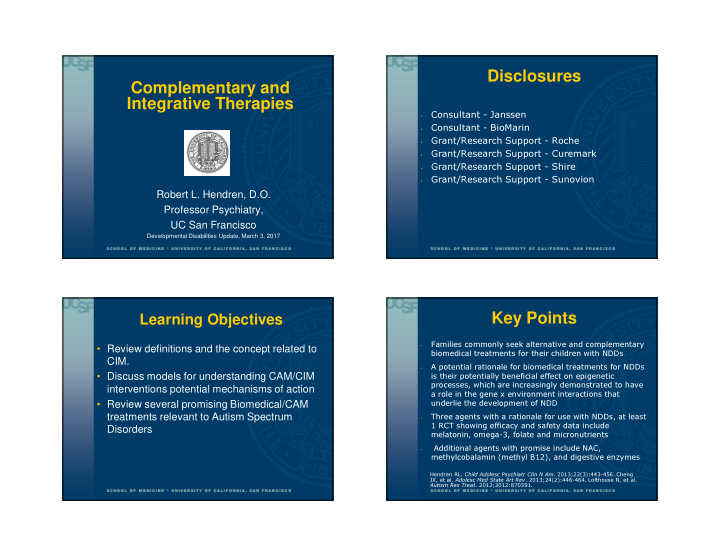



Disclosures Complementary and Integrative Therapies • Consultant - Janssen • Consultant - BioMarin • Grant/Research Support - Roche • Grant/Research Support - Curemark • Grant/Research Support - Shire • Grant/Research Support - Sunovion Robert L. Hendren, D.O. Professor Psychiatry, UC San Francisco Developmental Disabilities Update, March 3, 2017 Key Points Learning Objectives • Review definitions and the concept related to • Families commonly seek alternative and complementary biomedical treatments for their children with NDDs CIM. • A potential rationale for biomedical treatments for NDDs • Discuss models for understanding CAM/CIM is their potentially beneficial effect on epigenetic interventions potential mechanisms of action processes, which are increasingly demonstrated to have a role in the gene x environment interactions that • Review several promising Biomedical/CAM underlie the development of NDD treatments relevant to Autism Spectrum • Three agents with a rationale for use with NDDs, at least Disorders 1 RCT showing efficacy and safety data include melatonin, omega-3, folate and micronutrients • Additional agents with promise include NAC, methylcobalamin (methyl B12), and digestive enzymes Hendren RL. Child Adolesc Psychiatr Clin N Am . 2013;22(3):443-456. Cheng JX, et al. Adolesc Med State Art Rev . 2013;24(2):446-464. Lofthouse N, et al. Autism Res Treat . 2012;2012:870391.
Talking with Families about CAM/CIH Biomedical/CAM Treatments • CAM is “a group of diverse medical and health care • Ask family members if they have considered biomedical/CAM systems, practices, and products that are not treatments and which ones they might be considering generally considered to be part of conventional • Discuss reasons people consider biomedical/CAM treatments, medicine” (NCCAM now NCCIH) including thoughts that they might be safer because they are “natural” and the wish for health promoting agents • 12% of children and adolescents in the US use CAM • Discuss research evidence and where to find it, eg, (Birdee et al., Pediatrics, 2010; https://nccih.nih.gov/health/integrative-health) www.pubmed.gov • Up to 74% of children recently diagnosed with autism • Recommend agents with more evidence and caution against use CAM (Hanson et al., JADD, 2007) agents with little evidence and concerns about safety, eg, chelation • The main reasons for choosing CAM given were • Recommend a practitioner with expertise in the area of related to concerns with the safety and side effects of biomedical/CAM treatments in your region or suggest Autism prescribed medications. (Hanson 2007) Research Institute www.autism.com • Caution about how promising new treatments often do not hold up to good studies in all of medicine https://nccih.nih.gov/health/integrative-health • Ask that family let you know what they are using and how it is working for them Potential Biomedical/CAM Potential Biomedical/CAM Treatments Treatments (cont) • Actos • Craniosacral Therapy • Acupuncture • Curcumin • Animal Assisted Therapy • Cyproheptadine • Antibiotics • DHEA • Antifungals (Diflucan, Nystatin) • Digestive Enzymes • Antiviral (Valtrex) • Dimethylglycine (DMG, TMG) • Amino Acids • Fatty Acids (Omega 3) • Auditory Integration Therapy (Music Therapy) • 5 HTP • Chelation • Folic/folinic Acid • Chiropractic • Glutathione • Cholestyramine • Gluten/Casein Free Diet • CoQ10 • Food Allergy Treatment Lofthouse, N. et al Autism Research & Treatment, 2012; https://nccih.nih.gov/health/atoz.htm
Potential Biomedical/CAM Potential Biomedical/CAM Treatments (cont) Treatments (cont) • Hyperbaric Oxygen (HBOT) • Oxalate (low) Diet • Iron Supplement • Oxytocin • Inflixmab (Remicade) • P5P • Immune Therapies • Probiotics • IVIG • Ribose and NADH • L-Carnosine • SAMe • Magnesium • Secretin • Melatonin • Sensory Integration Therapy • Methyl B12 • Specific Carbohydrate Diet • NAC • St. John’s Wort • Naltrexone • Steroids • Neurofeedback • Transfer Factor Potential Biomedical/CAM Model for Neurodevelopmental Disorder Etiology Treatments (cont) • First hit - Genetic neurodevelopmental vulnerability • Vitamin A • Second hit - environmental “ stressor ” and • Vitamin B3 • Vitamin B6/Mag • Vitamin C interaction between the two • Zinc • Third hit - Restricted development
Translating from “ “ “ “ Terroir ” ” ” Model ” Translating Levels of Intervention Level 4 Level 3 Level 2 Level 1 Gene-Environment Interactions and Endophenotype Level 2 • Immune abnormalities/inflammation • Oxidative stress • Disturbed methylation • Mitochondrial dysfunction • Free fatty acid metabolism • Excitatory/inhibitory imbalance • Hormonal effects • Microglia Goines P, et al. Curr Opin Neurol . 2010;23(2):111-117. James SJ, et al. Am J Clin Nutr . 2009;89(1):425-430. Frye RE, et al. Pediatr Res . 2011;69(5 Pt 2):41R-47R. Manji H, et al. Nat Rev Neurosci . 2012;13(5):293-307. Bell JG, et al. Br J Nutr . 2010;103(8):1160-1167. Rubenstein JL. Curr Opin Neurol . 2010;23(2):118-123. Harony H, et al. Neurosignals . 2010;18(2):82-97. Cunningham CL. J Neurosci . 2013;33(10):4216-4233.
A New Paradigm (Levels 3 & 4) • Significant subsets of people with autism have intestinal inflammation, digestive enzyme abnormalities, metabolic impairments, oxidative stress, mitochondrial dysfunction, and immune problems that range from immune deficiency to hypersensitivity to autoimmunity • In many cases, improvement of autistic symptoms is achieved by a combination of nutritional recommendations, prescription medications, and addressing the underlying medical conditions seen in these individuals Mumper E. North American Journal of Medicine and Science . 2012;5(3):180-184. Can Autism be Prevented? (Levels 3 & 4) Parenting from before Conception • Autism Research Institute • Recent studies reveal that parental history and www.autism.com/prevention experiences also exert effects through epigenomic information not contained in the DNA sequence, including • My Child without Limits variations in sperm and oocyte cytosine methylation and http://www.mychildwithoutlimits.org/understand/autism/can- chromatin patterning, noncoding RNAs, and mitochondria autism-be-prevented/ • Transgenerational epigenetic effects interact with • David Berger, MD Pediatric Practice conditions at conception to program the developmental http://www.ageofautism.com/2012/05/dr-david-berger-on- trajectory of the embryo and fetus, ultimately affecting the mimizing-autism-incidence.html lifetime health of the child • Maureen McDonnell’s recommendations http://pathwaystofamilywellness.org/Informed-Choice/what- can-be-done-to-prevent-autism-now.html Lane M, et al. Science . 2014;345(6198):756-760.
Recommend
More recommend